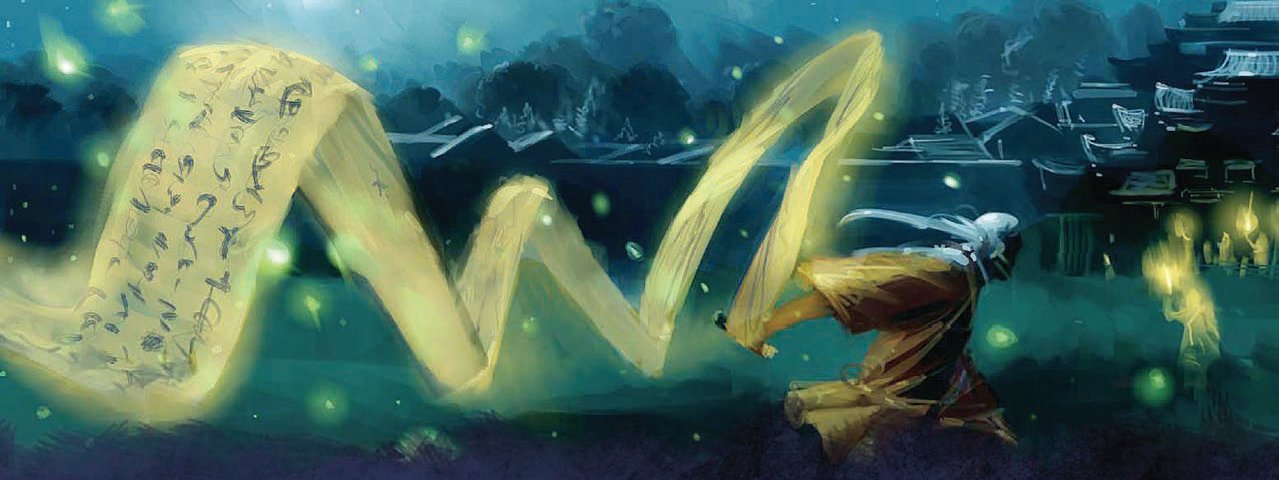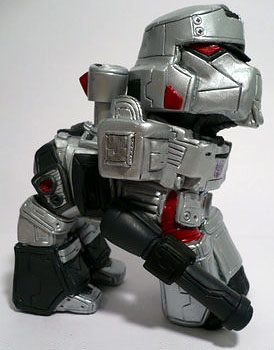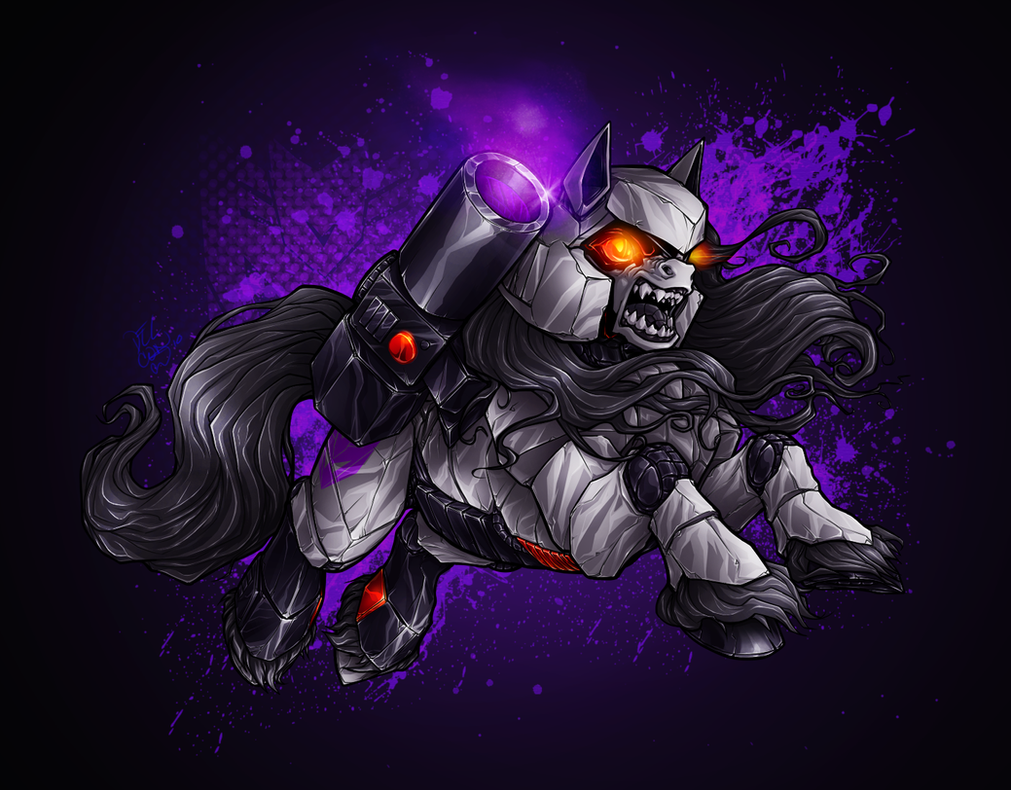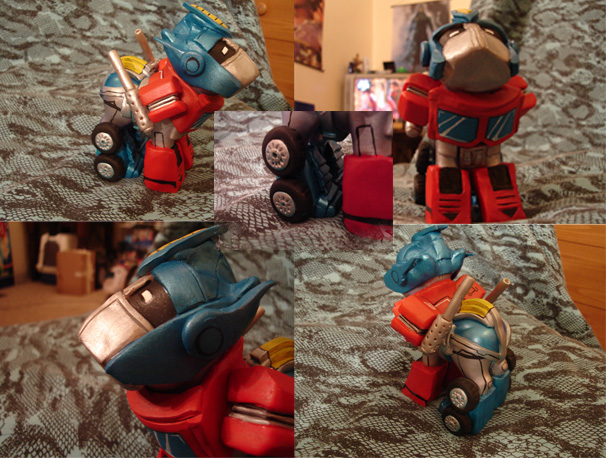In my previous post, I detailed the ur-religion of Rokugan as performed by the first humans, also known as the Tribe of Isawa. Now I must once again fast-forward a bit in our creation story by summarizing thusly:
The nine children of the Sun and Moon fell from the heavens. One of them, Fu Leng, fell away from the others, and his impact was such that he punched a hole straight into Jigoku (hell) and became a Villain To Be Named Later. Meanwhile, the others fell together (and more gently) and landed on Rokugan. When this happened, they immediately lost most of their divinity but still retained much power (demigods at the least.) One of these eight, Hantei, became Emperor and the other 7 swore fealty to him, creating the 7 Great Clans of the Emerald Empire.Two things are worthy of mention here:
- The Emperor and Clan Founders were also considered kami, because of their divine origins. In order to differentiate them from all the other kinds of kami, we are going to call them kami-sama (respected kami).
- Of the kami-sama, NONE of them were Shugenja. Just file that away for future reference.
Having read this, it should come as no surprise to anyone that the socio-religious order didn't change one whit. The Fortunes and O-kami were still worshipped; there were simply new bosses in town who were stronger and smarter than the old bosses. This is the foundation of the "We are samurai, we are better than you, because we are nobles and real people (i.e. descended from gods) and you are only half-people" caste system (also known as the Celestial Order), which is still present in modern Rokugan. More on this in a moment.
For the average human, life went on pretty much as normal: you farmed, you prayed, and you tried not to die from disease or starvation or angry samurai... for the first 33 years, that is, because that's when Fu Leng invaded Rokugan with an army of demons. Apparently, the youngest kami-sama (who'd spent decades absorbing Jigoku's power, and basically becoming the god of hell) decided he didn't like how his siblings never went looking for him, or he was angry that he hadn't been invited to the tournament where they decided who would be emperor, or whatever. He was hell's champion, it's not like he needed a reason to attack. But the upshot is that that Fu Leng and his minions proceeded to kick the crap out of everyone and everything. He had slave races of ogres and goblins, he commanded demons, and he knew blood magic which was so powerful that it corrupted the traditional blood magic of the Isawa such that anyone who performed it became Tainted (think cancer of the soul) with the corruptive power of Jigoku.
And just when it looked like the Empire was about to crumble, a little old man walked up to the Emperor and said, basically, "The solution is right in front of you, but you're too blind to see it. Listen to what I have to say and I can solve all of your problems."
The Emperor said, essentially, "Oh yeah, old man? Prove it."
And the old man, whose name was Shinsei, did just that. He took seven mortals -- not the kami-sama, but humans -- and the eight of them kicked the crap out of a demon-god, routed his armies, and bound him for over a thousand years.
Of course, Shinsei died while doing this, but his lessons -- many of them spoken to the Emperor himself -- were written down, and they became the Tao (Way) of Shinsei. These written lessons formed the core of Shintao, and they revolutionized EVERYTHING.
There are really only two major tenets to Shintao, and you've already read both of them. The first is the concept of elemental rings, and how there is a progression of spirits from smallest to largest. This is the lesson learned by all shugenja, and without Shinsei, there would be no shugenja on Rokugan.
The second tenet is the teaching that All Are One, the concept of universal unity through void.
Big whoop, I hear you all say. We know this already. Yes, but what you are failing to grasp is the true application of these two principles, which is this:
If the void touches and encompasses and unifies everything, then I am everything and everything is me. I am the soil beneath my feet and the air that I breath. I am the tree under which I shelter and I am the fire that keeps me warm. I am the animals I eat. I am you. I am all of creation.
You know what else is all of creation? That's right, the O-kami.
Shintao says, "You are god and you don't even realize it. The only reason you can't access that power is because you aren't enlightened enough to access it. Get out of your own way and realize your own divinity."
Now just think about this for a moment. Shinsei says that this filthy peasant here is you. And you are that filthy peasant. And both of you are gods.
Shintao was not the great equalizer, it was the great humbler. It took the notion that the gods were somehow set apart and unattainable to all but a select few, and it threw that notion to the ground and stomped the pieces into dust. This is amazingly heretical stuff, because there is nothing an entrenched caste system hates worse than being told its repressed underclass is equal to them.
But Shinsei got away with it, precisely because Rokugan needed to topple a god from his pedestal. Because of that, and his success, and the heroic sacrifice of himself and the Seven Thunders, Shinseism became revered and codified into Shintao.
This heralded the emergence of the first truly ethical belief system in all of Rokugan. It works because it is very simple: "If all are one, then any wrong done to another is wrong done to yourself, and kindness shown to another is kindness towards oneself."
Or, put more succinctly, "Don't be a douche to yourself, dude."
In addition to a moral system, it also unified the Rokugani system of spirituality. Why are the kami amoral? Because man is inherently amoral, because you are them and they are you. Want them to act ethically? Then act ethically yourself. Karma, right action, social order, all of these things came about because a little old man said "I have empathy for you as if you were me."
This puts monks in a very interesting social position. Technically, they are peasants, but they are also highly esteemed due to their religious devotion. Only samurai can become shugenja, because shugenja training requires time and education and resources which non-nobles simply don't have, but anyone, even the filthiest untouchable, can shave his head, join a monastery, and seek enlightenment. At the same time, when samurai reach old age and retire, they often become monks in order to prepare their souls for the afterlife.
Monks are a social aberration because they allow anyone to join their ranks. They are an escape from, and an exception to, the caste system. Yesterday's gravedigger can become tomorrow's abbot who gets to order a freshly retired samurai to clean out the toilets because he's the newest novice.
Of course, despite being (by Imperial Decree) one of the core religions of the Empire, not everyone reveres Shintao equally. Peasants love monks (who are far more approachable than shugenja) but are typically too busy trying to feed their families to tend to spiritual correctness and Right Action. Samurai should be mindful of Shintao at all times, but compassion for others gets a bit... muddied... when bushido states you have to serve your lord faithfully, and he's just commanded you to kill those other people.
Also, frankly, most samurai are douches. There's a Rokugani saying which goes "Samurai are cursed to be reborn as samurai," which basically means that your karmic punishment for killing people in the name of honor is to be reborn as an ass who kills people in the name of honor. It's far, far easier for peasants to achieve enlightenment, or at least escape the karmic cycle of reincarnation, than it is for samurai.
The upshot of all of this is that most samurai pay only lip service to Shintao, because Fortunism is what get things done. This really only changes at the end of their lives, when they realize they may have to answer for all the bad things they've done in service to their lord.
This concludes the Basic Course of Coherent Rokugani Cosmology, and is all you need to know in order to play. More sophisticated topics will be addressed in the Advanced Course.
If you have any questions, now is the time to ask them.























